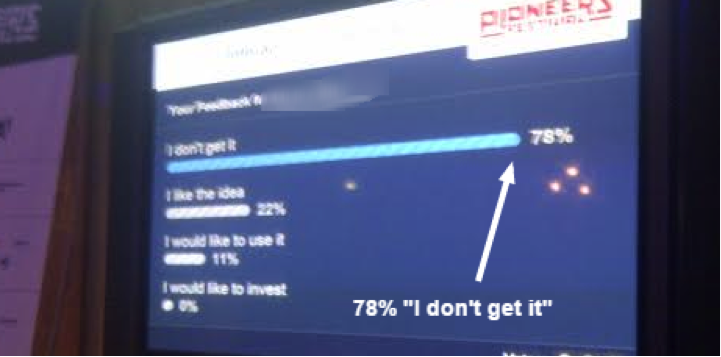Editor’s note: Andrew J Scott is a serial entrepreneur and early stage investor looking for startups that can become billion-dollar companies.
I’ve pitched at least 250 investors over the years, mentored hundreds of startups and have plenty of fail behind me. So I feel I know a thing or two about pitching, and European startups are so often really rather bad at it.
Austria, and specifically Vienna, is famous for classical music and Sachetorte more than tech startups, but I’d heard good things about Pioneers Festival and so wearing my early-stage investor hat, I found myself consuming 50 startup pitches at the Haus der Industrie. To give yourselves a better chance of securing funding – and customers – here are 10 suggestions to get right.
1. Problem/Solution Fit
Define what you do; this is the most basic aspect of a pitch. To my ongoing astonishment, this so often gets overlooked or poorly communicated.
According to the interactive event app (which allowed investors to submit questions and vote) at least half of the startup pitches didn’t communicate clearly what they do. Top of the feedback was “I don’t get it.” Often the judges didn’t get it either and had to ask in the Q&A.

The size of the problem you solve and how well you solve it creates the value in your business. There is simply no excuse for not being able to pitch coherently the problem you solve and how you solve it in one minute let alone three minutes.
A good test is to pitch your Mum (use your team’s family, too). This is a serious suggestion. If your mother understands it then you’ll guarantee tech investors (and your customers) understand what, why and how, too.
2. Speak English Clearly
As a born English speaker whose only second language is French in the form of a pigeon, I feel a tinge of guilt criticising others who don’t get to pitch in their native tongue, but the harsh truth is that unless you can speak clear English as a CEO pitching an international market, you’re going to struggle. I’ve even heard that a Y Combinator representative said that CEOs with “thick unintelligible foreign accents” quite simply fail.
Record yourself and ask a native speaker their honest opinion. Better, record yourself and ask other people for whom English is their second language. Invest in lessons/speech therapy if necessary. And in addition to that…
3. Speak Slowly
As an occasional MC/speaker I certainly still sometimes fall foul of this. Speaking more slowly does not come naturally. It feels odd. But it sounds good. Slower speech will not only help with clarity if you have a strong accent, it will give you more gravitas. There are lots of great resources to help you improve your speaking; this is one of many. If you feel that you’re talking way too slowly, you’re probably speaking about the right speed.
4. The Right Slides
Too many decks continue to be confused, bloated, overly complex or all three. I’d recommend you take Sequoia’s template as a starting point, though some cash / revenue projections may not apply if you’re very early stage. They’ve made a lot of money in this business. If it’s good enough for them, it should be good enough for most investors.
Bear in mind obviously the content will change depending on whether this is a deck to be read, studied closely pre-investment or something you’re presenting in three minutes. Equally, if your presentation is just three minutes you obviously wouldn’t include all these slides; apply common sense.
5. Less Is More: Simple Content
If I’m reading a slide, I’m not listening to you. When I’ve finished reading, I’ll look at you again and start listening again. You have precious seconds to make an impression and you want people to engage with you, the human being on stage, and listen to what you’re saying.
Complicated slides compete for audience attention. Why set yourself up with a competitor? Steve Jobs was possibly the king of scarce slides, using imagery and allegedly never more than three bullet points and usually only a word (or three) each. You may not be launching the new iPhone but you can steal Steve’s tricks to help keep people focused on the important things: What you’re saying.
6. Tell a Story
Humans are emotional animals; yes even investors. With a three minute pitch (as it was at Pioneers) you might think it’s a distraction to tell a story. But don’t forget story telling is the most ancient of modern human’s ways to communicate information, be it cave gossip or religion.
Half your challenge is to engage the audience within the first 5-10 seconds before their heads tip back down to phones and laptops. A snappy authentic story which positions your problem / solution fit can engage and differentiate you. Don’t include fluff (this isn’t bedtime story telling) but providing context and stimulating curiosity in the first 30 seconds, may mean people leave the wifi alone for the remainder of your pitch.
7. Practice!
If you believe Malcom Gladwell then 10,000 hours is the time it takes to become supremely accomplished at anything. That’s not feasible for your pitch obviously, but practicing 10, 20 or 50 times is. With all the cost and time to attend a conference, not to mention the subsequent impact your 1, 3, 5 or 10 minute pitch will have on an audience, practice really will help make perfect.
So many founders I know don’t properly practice their pitches for specific events which often have specific pitch lengths. So practice; rinse, wash, repeat. It will really pay off.
8. Pause
Before you begin, take a few seconds to pause. There’s more about this in the book I recommended above. Gaining composure and asserting yourself on the stage is vital and you can afford five seconds to avoid the impression of a manic hyena, before you launch into your winning pitch.
9. Answer questions quickly
The Q&A session is a great time to show your mettle. Perhaps surprisingly, this is closely linked to practice. If you’ve not pitched “friendly” investors, your team, your family or others, you won’t be used to answering the tough questions.
Get to the point when answering the question and if cornered (e.g. because an investor asks your valuation or you don’t know the answer) know in advance what you’re going to say, even if it’s “I’m happy to discuss that afterwards off stage.”
Even if you’re a seasoned pitch artist for your startup, sit down and write the 10 questions you’d hate to be asked. They’re probably exactly the ones you’ll get.
10. Hire a Coach
You can hire a coach or get a mentor or another entrepreneur to help you shape your deck, but you can also hire a coach to help you with your presentation skills.
Given how important a snappy delivery with absolute clarity in a startup world of elevator pitches is, paying for a day or two of presentation coaching (assuming you hire someone good) could make all the difference the next time you’re onstage, and it’s something startup founders rarely seem to see value in doing.
Don’t forget, even the most populous leaders in our world do this – from Presidents to Prime Ministers – they all have coaches or have been coached.
In Conclusion
There are many more tips and tricks you can employ (and far better speakers or teachers than I out there who can give them) but reviewing the performance of the 50 startups Pioneers, these thoughts were the elephants in the room, which, as startup founders, you need to take outside the zoo and aggressively cull from your startup pitches.
It’s worth adding that conference teams themselves can sometimes be guilty of compounding problems. If you’re a conference organizer, these are my top three gripes as an attendee watching pitches or having been a founder having to pitch:
Bad MC. It continues to amaze me how poor so many hosts are at tech conferences and I find myself wondering why they were chosen. Despite “only” introducing each startup, the MC sets the whole tone of an event – they define the energy in the room. They should be able to connect with an audience, gain the audience respect and carry the audience with them if there are problems and keep things on time gracefully.
Being an MC is hard. I know, I’ve done it and I can always improve. So pick your MC carefully, ask them how they will prepare, ask them what’s important about being an MC, get recommendations and don’t consider it an afterthought – they will make or break the perception of your event.
Poor AV or presentation transition. You have plenty of time to test and practice rapidly changing pitch decks and to confirm that your sound system works. Don’t make a founder’s job even harder when they’re already wracked with nerves by fiddling around with PowerPoint/Keynote problems.
Poor acoustics. You’re presumably paying an AV company to run your sound system. If you’re in the pitch room and speech isn’t clear, it’s their job to fix it. Or, don’t pick a room with naturally awful acoustics for voice. Somewhere which is good for chamber music, may not necessarily be good for startup pitches.
Epilogue: The Audience
I’d like to end on a note to the audience at these events.
We Europeans are a hard crowd to please and there’s nothing worse than being an MC or a founder speaking to an audience of unengaged stones. So next time you’re asked to welcome someone on stage, give them a truly energized round of applause or hey, laugh at the MC’s joke even if it’s not going to win him an Emmy Award… Just a little bit of enthusiasm, even if feigned, goes a long way.
